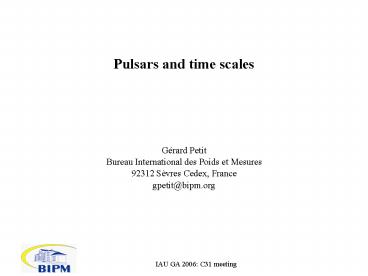Pulsars and time scales - PowerPoint PPT Presentation
1 / 18
Title:
Pulsars and time scales
Description:
A very good pulsar may be as good as one clock above one year ... being the main users of the very long term stability of atomic time scales ... – PowerPoint PPT presentation
Number of Views:77
Avg rating:3.0/5.0
Title: Pulsars and time scales
1
Pulsars and time scales
- Gérard Petit
- Bureau International des Poids et Mesures
- 92312 Sèvres Cedex, France
- gpetit_at_bipm.org
2
Résumé
- EAL, TAI, TT(BIPM)
- Atomic time 10 years ago and now
- Pulsars and time
- Conclusions
3
Atomic clocks 1996
- First HP5071A appeared 1993
- A factor of 2-3 improvement in stability over
previous clocks - Laboratory Cs standards attain 1x10-14 accuracy
(here NIST7, also PTB, etc...). - And the first Cs foutain was operated in 1995.
4
Atomic clocks now
- Industrial clocks not very much changed
- Cs fountains in
- SYRTE FO1 (in 1995-1997), FO2 and FOM (since
2002) - NIST F1 (since end 1999)
- PTB CSF1 (since mid 2000)
- IEN CSF1 (since 2003)
- NPLCSF1 (since 2004)
- NMIJ JF1 (since 2005)
- more coming
SYRTE Paris
NIST Boulder (USA)
5
EAL, TAI and TT(BIPMxx)
- TAI calculation (real time)
- Each month, BIPM computes a free atomic scale EAL
from more than 250 atomic clocks worldwide. - Each month, primary frequency standards (PFS) are
used to estimate f(EAL). - The frequency of TAI is then steered
- TT(BIPMxx) calculation
- Post-processed using all available PFS data, as
of year 20xx. - f(EAL) is estimated each month using available
PFS. Monthly estimates are smoothed and
integrated to obtain TT(BIPMxx). - Last realization TT(BIPM05), released in March
2006.
6
Atomic time 10 years ago, 1996
- G. Petit, P. Tavella, Pulsars and time scales,
AA308, 290, 1996 - G. Petit, Limits to the stability of pulsar time,
Proc. PTTI, 1995 - Atomic time TAI
- Stability from 150-170 clocks, HP5071A just
appeared. - Accuracy and long-term (years) stability from 6-8
Cs tube PFS Best value is 1x10-14 - 1-2 year instabilities 1x10-14 possible
- TT(BIPM)
- Post-processed, mainly based on PFS
- 1-2 year instabilities
7
Atomic time now, 2006
- G. Petit, Long term stability and accuracy of
TAI, Proc. EFTF, 2005 - (This meeting for recent publications on pulsars)
- Atomic time TAI
- Stability from 250 clocks, mostly HP5071A and
H-masers - Accuracy and long-term (years) stability from 6-8
Cs fountain PFS Best accuracy is 4x10-16 - 1-2 year instabilities 2x10-15 still possible,
but not likely - TT(BIPM)
- Post-processed, mainly based on PFS
- 1-2 year instabilities
8
Comparison of EAL to TT(BIPM)
- f(EAL) is compared to TT(BIPM) Some systematic
frequency trends persist for many years
9
Stability of the free atomic time scale EAL
- Improves over time, mostly for 10 d to a few
months - For several years, limited to the 10-14 level
10
TAI is not as accurate as TT(BIPM). Instabilities
of several 10-15 over a few years are possible
11
The latest realization TT(BIPM05)
- Post-processed in early 2006 using all primary
frequency standards data until December 2005. - Frequency accuracy over the period under study
decreases from 6x10-15 in 1993 to about 1x10-15
since 2001.
12
Limits to the stability of pulsar time (1995)
13
D. R. Lorimer, "Binary and Millisecond Pulsars at
the New Millennium", http//relativity.livingrevie
ws.org/Articles/lrr-2001-?/
14
D. R. Lorimer, "Binary and Millisecond Pulsars at
the New Millennium", http//relativity.livingrevie
ws.org/Articles/lrr-2005-7/
- 193721 and 185509 are same old data
- J0437-4715 is from A. Hotan (pers. comm. to
DRL). It has very low timing noise (100 ns). Not
found published long-term timing analysis.
15
If we update the performance of atomic time
- A very good pulsar may be as good as one clock
above one year - Atomic time will not be worse than 1x10-15 in
the future.
16
List of best ms pulsars(compiled by Jason
Hessels)
- Should be ms (of course), bright, narrow pulse,
not too much dispersed, not in a cluster, have a
low Pdot? - J0437-4715 P 5.76ms DM2.6 pc cm-3 D140pc
- S400 550mJy S1400
137mJy Binary - J17130747 P 4.57ms DM16.0 pc cm-3 D1.1kpc
- S400 36mJy S1400
3mJy Binary - B185509 P 5.36ms DM13.3 pc cm-3 D910pc
- S400 31mJy S1400
4mJy Binary - J1909-3744 P 2.95ms DM10.4 pc cm-3 D820pc
- S400 ? S1400 3mJy
Binary - B193721 P 1.56ms DM71.0 pc cm-3 D3.6kpc
- S400 240mJy S1400
16mJy Isolated
17
Conclusions (1)
- TT(BIPM), updated yearly, has accuracy and
long-term instability at about 1x10-15 over the
recent years. - TAI, available every month, is less accurate and
stable than TT(BIPM), but not worse than a few
10-15 over the recent years. - Primary frequency standards (PFS) have gained
about one order of magnitude in accuracy every
10-12 years, and this expected to continue. We
are at 4x10-16 . - The full accuracy of PFS may not be completely
represented in TT(BIPM) because of - the small number of PFS, and their irregular
operation - the noise of frequency transfer
18
Conclusions (2)
- Pulsars long-term stability may reach 10-15 and
would not supersede atomic time scales. - Nevertheless they are useful for time scales in
- being the main users of the very long term
stability of atomic time scales - providing flywheels to transfer the current
accuracy of atomic time to the past, or to the
future. - And of course they are fundamental tools to
investigate a variety of physical phenomena.































